| Further Education
The Wednesbury Institute was founded in 1884 by
Joseph Smith and Frederick William Hackwood, the
eminent
historian. The institute arranged
talks, entertainment, lectures, and an annual
‘Conversazione’ consisting of light music,
entertainment and short talks. Some of the talks
were given by well-known speakers including Mr.
Oscar Wilde, Mr. Chillington Hunt, and Mr. Harry
Furniss.
In 1885 the Wednesbury
Institute began holding classes in the Town Hall.
They were held on every alternate Wednesday. The
Institute had a large membership. In 1884 there were
759 members, which had risen to 811 in 1885. There
were 749 members in 1886, and 829 in 1887. A full
membership cost 10s.6d., a family membership cost
5s.0d., and an artisan membership cost 3s.0d.
In 1884 science and art
classes, and elementary and advanced classes in
French were held in the old Free Library that stood
on the corner of Walsall Street and Brunswick
Terrace. The classes continued until 1892 when they
were taken over by the Municipal Technical School.
In 1889 the Higher Grade School
opened. It was a privately owned institution run by
the headmaster James Longstaff. It provided pupils with comprehensive courses in French,
chemistry, mechanics, machine construction, and
drawing. The tuition fee was one shilling per week,
which included all of the necessary books. The
school could cater for 120 pupils, but in practice
the number never exceeded 90. In 1890 there were
only 48 pupils. The school survived until 1900, but
suffered due to competition from the Municipal
Technical School.
Science School
On August the 12th, 1896, a new Science School,
occupying a position between the Post Office and the School Board
Offices was opened by the Mayor, Councillor Knowles. The building
included an exhibition room with a valuable collection of chemical
and metallurgical specimens, a metallurgical laboratory, with
furnace room attached, a balance room, and a photographic developing
room.
|
|

The Science School, as it
is today. |
Above the exhibition room and metallurgical
laboratory were the chemical and physical laboratories, a lecture
hall, a classroom, a balance room, a gas analysis room, stores, and
a teachers' preparation room. Included in the building were
four stained glass windows, one of which was given by J. H. Thursfield,
the 3rd mayor of the borough. It represented a
laboratory with the portraits of Lord Kelvin,
Faraday, Davy, and Roger Bacon.
Another window, given by Councillor J.
Knowles, the 5th mayor, represented a blacksmith at work, with
portraits of Stephenson, Bessemer, Watt and Siemens,
corresponding with those in the other window.
The two others in the
lecture hall represented a working colliery and the Willingsworth
iron furnaces. The building was designed local architect C. W. D.
Joynson and built by Thomas Tildesley of Willenhall at a cost of
£2,467.
The school's roll was to teach the proper way
of using a large range of tools, and to give the student an
intelligent grasp of workshop practice. |
|
Municipal Technical School
This institution, formed in September, 1892 at
the Art Gallery, succeeded the old Science and Art Classes. Tuition
was given in the following subjects:
| Chemistry;
Physics; Metallurgy; Iron and Steel
Manufacture; Metalwork; Woodwork; Machine
Construction; Mechanical Drawing; Freehand,
Model, Geometrical and Perspective Drawing;
Drawing from the Cast and Shading;
Elementary Design; Plant Drawing; Monochrome
Painting; Elementary Geometry; Needlework;
Shorthand (Pitman's system); Practical
Mathematics; Applied Mechanics; Practical
Drawing; English; Book Keeping; Music;
Dressmaking; Cookery; and Typewriting. |
Some classes were held at the
Science School and others at the Art Gallery. The
school's governors were eight local councillors, and
eight prominent citizens. The Mayor was Chairman, and
the Town Clerk, secretary. It later became the County
Metallurgical and Mining Institute, which in turn became
Wednesbury County Technical College.
On 22nd June, 1912 Wednesbury
Education Committee approved plans for the County
Metallurgical and Mining Institute, which would be
on a new site with metallurgical, engineering, and
chemical laboratories, and an applied mechanics
room, lecture rooms, and classrooms.
|
|
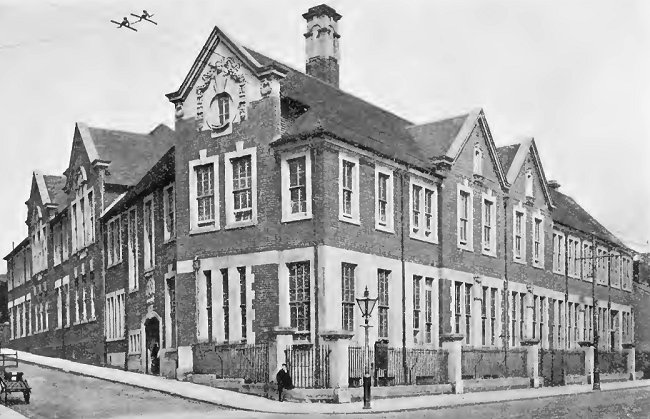
The Technical
College in 1918. |
|
Land was purchased at a cost of
£1,000 from Benjamin Charles Knowles and John James
Knowles. It was on the corner of Walsall Street and
Kendrick Street. The new building was built by H.
Gough & Son, 530 Dudley Road, Wolverhampton at a
cost of £13,468, and in April 1914 the first members
of staff were appointed. Walter MacFarlane became
Principal, and Dr. W. E. Fisher was Head of
Engineering. Several posts were also advertised
including a junior engineering lecturer, and a
caretaker. Other appointments included
four instructors in metallurgy, four instructors in
engineering, another in practical mathematics,
a clerical assistant, a clerk, and a laboratory boy.
Classes began on 21st September, 1914.
|
|
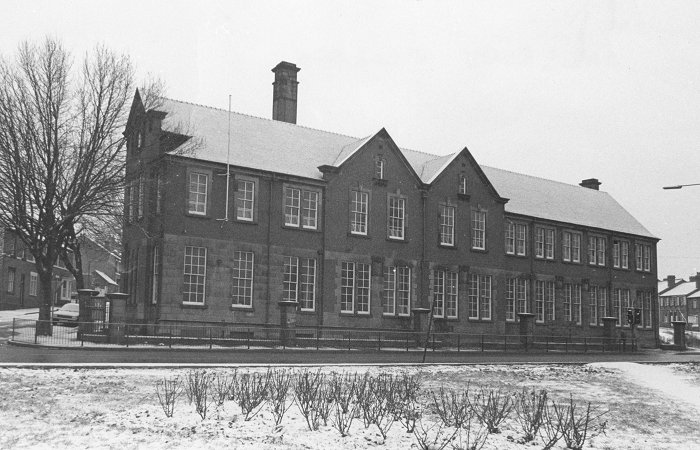
The college in
Walsall Street. Kendrick Street is on
the left. Courtesy of Brian
Groves and John Hellend. |
|
The Metallurgical Department
occupied the whole of the upper floor of the Walsall
Street wing. There was a furnace room with eight
crucible furnaces, a laboratory with benches for
fifty-six students, balance rooms, and rooms for
pyrometry combustion, electro deposition, fuel
testing, metalography, and photography. The Engineering Department, also in
the Walsall Street wing, had laboratories for
applied mechanics and general engineering. Machinery
included seven screw cutting lathes, a planer, a
shaping machine, two drilling machines, pulley
blocks, and an experimental flywheel. There was also
a smith's hearth with electric blower, a 16 bhp. gas
engine, a testing machine with a capacity of
30,000lbs, and a gas fired boiler. The Kendrick
Street wing had chemical and physical laboratories,
a drawing office, lecture theatres, and classrooms.
During World War One the land
at the back of the buildings was cultivated, and
courses were run for munitions workers. In 1920 the
institute became Wednesbury County Technical
College.
Wednesbury County
Technical College In 1928 the
college had a new Principal, Mr. T. G. Bamford, and
the college was enlarged. Three acres of adjacent
land were purchased for the building of a foundry
and pattern-shop, an X-ray laboratory, a
photographic laboratory, physical metallurgical
laboratories, an automobile workshop and several new
classrooms. In between 1933 and 1939 around £9,000
was spent on the most up-to-date machinery and
apparatus so that the college became one of the best
equipped educational establishments in the country,
turning it into a specialised institution dealing
with advanced work in engineering, metallurgy,
foundry work, pattern making, and related subjects.
In World War Two the wartime
training included courses for welders, radio
mechanics, army fitters, and engineering cadets.
By the early 1950s the country
was suffering from a shortage of suitably skilled
technologists. Other similarly advanced
manufacturing countries had far more, and so plans
were made to attract a larger number of suitably
qualified school leavers, and to develop links with
industry to encourage manufacturers to send
employees for training.
When Mr. Bamford retired in
1952, his replacement, Mr. MacColl realised that
extra accommodation would be needed to enable the
college to cater for a larger number of pupils. As
an interim measure, the college acquired a number of
empty buildings in nearby Knowles Street, that could
be converted for educational use. It was realised that
the only long-term solution to the problem of
accommodation would be the building of a larger
college, but that was not to happen for nearly
twenty years.
The Knowles Street site
included workshops for metrology, materials and
structures, and electrical installation. There were
new drawing offices, and laboratories for production
engineering, hydraulics, and engineering science.
There were also workshops for heat treatment, hot and
cold working of metals, a core shop, a sand
laboratory, a welding shop, spectroscopy
laboratories, and a test house and workshop. One of
the buildings on the site was used by the newly
formed School of Photography which had eleven rooms.
Other rooms were used for the teaching of
domestic science. The site also included a new
gymnasium which was occasionally used as an assembly
hall.
|
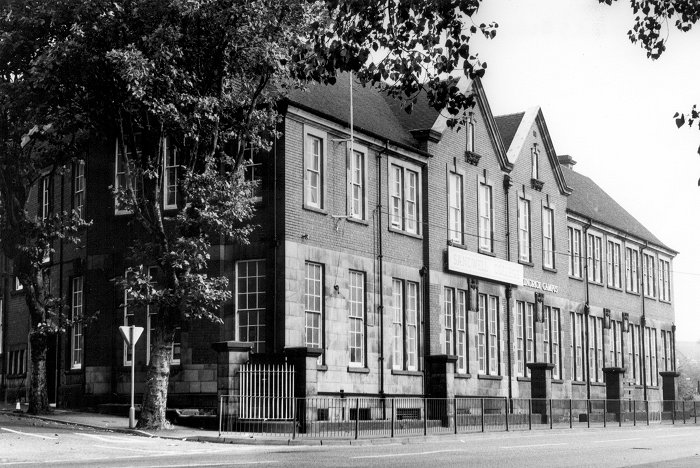
The college at a later date. Then called
Kendrick Campus, a part of Sandwell
College. Courtesy of Brian
Groves
and John Hellend. |
|
Additions to the original
Walsall Street site included a new canteen, a new
library, a foundry cupola furnace, pneumatic
moulding machines, a 5 cwt. drop hammer, equipment
for gamma radiography, a 300 Kv x-ray machine, and a
new Department of Science with Mr. A. J. Whitmarsh
in charge. It would initially act as a service
department for engineering and metallurgy, but would
soon run courses of its own.
The college had excellent exam
results. In 1952 there 516 entrants for City and
Guilds exams, and 331 passes, and also a sixty
percent pass rate for ONC and HNC exams.
Mr. MacColl retired in 1968 at
a time when work was beginning on the new site in Woden Road South, which was soon to be the college's
new home.
Staffordshire College of Commerce
It began on 25th April 1925 when Staffordshire Education Committee decided to appoint
a county lecturer in commercial subjects, after a
report by H.M. Inspectors highlighted the lack of
teaching in this area. The post was taken by Walter
Leslie Cottier from Liverpool, who started on 1st
September, 1925. A sub-committee on commercial
instruction in South Staffordshire was quickly
formed, and on the 27th March, 1926 the committee
proposed that negotiations should begin with
Wednesbury Education Committee for the establishment
of a centre for senior and advanced commercial
instruction, that would be located at Wednesbury
Municipal Technical School, and open in September
1926. The Education Committee approved the scheme
and commercial classes began in September as
proposed, in the old Science School in Holyhead
Road. Mr. Cottier became principal, and six
part-time lecturers and a clerical assistant were
appointed. They were assisted by several
instructors. Subjects taught included book keeping,
accountancy, banking, economics, commerce, English
literature, French, shorthand, and typewriting. In
1927 the Staffordshire Education Committee decided
that a new School of Commerce should be opened in
Wednesbury. A suitable property at Wood Green came
onto the market in 1929. This was The Limes, 75 Wood
Green Road, which had been home to local
industrialist Edwin Richards, his wife Mary Anne,
and their children. The property with 4,880 square
yards of land was auctioned at the White Horse Hotel
on the 15th July, 1929. The house and grounds, which
were ideal for the school, were sold to the County
Council for £2,000. New heating and lighting were
installed in the house, and cloakrooms and a cycle
shed were added. The County Commercial College was
officially opened by Alderman W. Bostock on the 26th
July, 1930. Members of staff included the principal,
Walter Leslie Cottier, William W. Enoch, assistant
lecturer in commerce, Miss F. M. Price, lecturer in
French, Mrs Dickin who taught shorthand and typing,
and Miss Lester, the clerical assistant. |
|
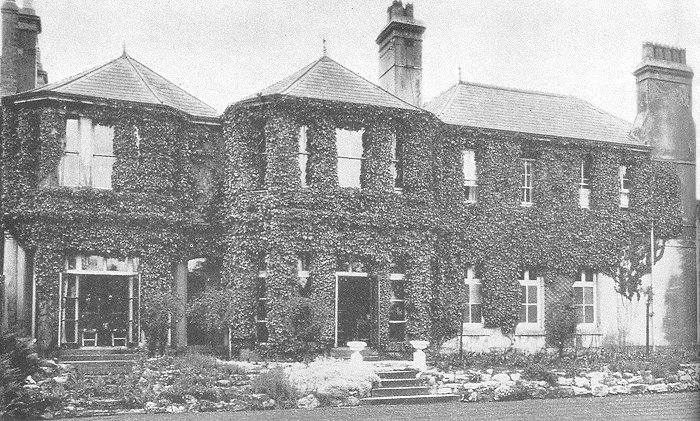
The
Limes. |
| The
college had a football team under the charge of
Harold Harman. They played at Elwell's recreation
ground in St. Paul's Road. There was also a ladies'
hockey club, and a tennis court in the college
grounds. In the early 1930s, several new courses
began including modern drama, taught by Mr. Walker,
and salesmanship, and advertising. The number of day
courses greatly increased, and in 1935 Mr. S. J.
Bell who had previously taught at Bilston Central
School joined the staff, to teach commercial
subjects. Other new members of staff included Miss
Jennie Jones who taught typing, and Miss Fanny
Mason, who taught elocution. In October 1936 Mr.
Cottier resigned to take a post on the Board of
Education. He was replaced temporarily by Mr.
Harman, who was later permanently appointed as
Principal. In 1937 a new High School of Commerce for
South Staffordshire opened at Wolverhampton and
Staffordshire College of Technology. This involved
the transfer of some of the courses from Wednesbury
to Wolverhampton, which led to a reduction in
teaching at Wednesbury. Mr Harman did his best to
stimulate recruitment and keep as many courses as
possible running. Also in that year the college had
a new clerical assistant,
Miss O'Reilly. By the
mid 1940s there were only
six full-time members of
staff, including the
principal. Seven classrooms
were in regular use at The
Limes, and at times lessons
were held in the library and
the staff room. The
prospectus listed forty-one
classes including six in
English, five in shorthand,
and five in book keeping.
During World War Two the
basement of The Limes became
an air raid shelter, and air raid shelters were built in the rose
garden. Two members of staff were trained for
A.R.P. duties and first aid, and the gardens were turned
into a vegetable patch as part of the 'dig for
victory' campaign. In 1940 the college acquired
a lease on neighbouring May Villa, which was used as a
students' common room, a dining room, and
classrooms. In 1945 two new clerical assistants
for Miss O'Reilly were
appointed, as were Mr. E. T.
S. Hoffman who became the
senior assistant in
commercial subjects, Mr. J.
C. W. Day who taught
accountancy, and Mr. R. E.
Handly who became a
temporary member of staff.
In the same year, May Villa
was compulsory purchased
after previous attempts to
purchase the building had
failed. The college was also
offered the use of Myvod
House, across the road from
The Limes. The house had
once been the home of Wilson
Lloyd, his wife Margaret and
their eight children. It had
been acquired by Wednesbury
Council and was used during
the war as a
nursing home, and by the
civil defence. At the same time the
two properties, Dolobran and
Old Kinvarra on the corner
of Wood Green Road and
Brunswick Park Road were
compulsory purchased for the
college, at a total cost of
£3,760. |
|

Dolobran. |
|
|
In 1946 part of the garden at The Limes was
cleared, and single storey prefabricated buildings
were erected on the site to house a new dining room
and kitchen, an assembly hall to accommodate 250
people, a typing room, and classrooms. From
September of that year, under the terms of the 1944
Education Act, the junior courses for 14 to 16 year
olds joined with a Junior Technical School, to become
a Technical High School. Even with the addition of
the new buildings, the accommodation proved to be
inadequate. The number of staff and students
increased, as new courses including more foreign
languages, and even a dancing class were intoduced.
Staff and student numbers were as follows:
| |
|
|
|
|
Year |
Full time members
of staff |
Part time members
of staff |
Student numbers |
|
1945/46 |
6 |
31 |
1.032 |
|
1946/47 |
12 |
37 |
1,298 |
|
1947/48 |
12 |
32 |
1,411 |
|
1949/49 |
13 |
43 |
1,497 |
|
1949/50 |
14 |
53 |
1,654 |
|
1950/51 |
16 |
59 |
1,865 |
|
1951/52 |
18 |
48 |
1,315 |
|
1952/53 |
21 |
57 |
1,285 |
|
1953/54 |
22 |
53 |
1,323 |
|
1954/55 |
23 |
46 |
1,402 |
|
1955/56 |
24 |
52 |
1,384 |
|
1956/57 |
26 |
43 |
1,471 |
|
1957/58 |
27 |
45 |
1,803 |
| |
|
|
|
1959 was a significant year for the college.
The long expected purpose-built college building was
erected in part of the garden of Myvod House, and
opened at the start of the academic year. The
building included a hall and stage, a canteen, a
sizeable library, eight classrooms on the first and
second floors, and offices and staff rooms on the
ground floor. It supplemented the original
buildings, which remained in use. In 1961 it became
the Staffordshire College of Commerce, and staff
numbers were increased to cater for new courses,
particularly in the new Management Department. There
were 32 full time members of staff, and 64 part time
members of staff. The new library had 6,000 volumes,
a new librarian and assistant librarian. The number
of books rapidly grew to over 8,000 with 700 student
borrowers. In the first year the new Management
Department had 502 students, and the college
embarked on a rapid expansion programme. There was a
massive demand for accountants in industry, and an
equally large demand for management studies courses.
In the year 1962/63 the canteen served 40,000 midday
meals and 18,000 evening meals, which greatly
stretched its resources, and led to overcrowding.
Plans were made to extend the canteen to three
times its original size. The library suffered from the
same problem, which caused a lot of overcrowding. Its
84 seats were proving to be inadequate, and there
was insufficient shelf room to cope with the 2,000
new titles. As a result the college was extended in
1965. |
|
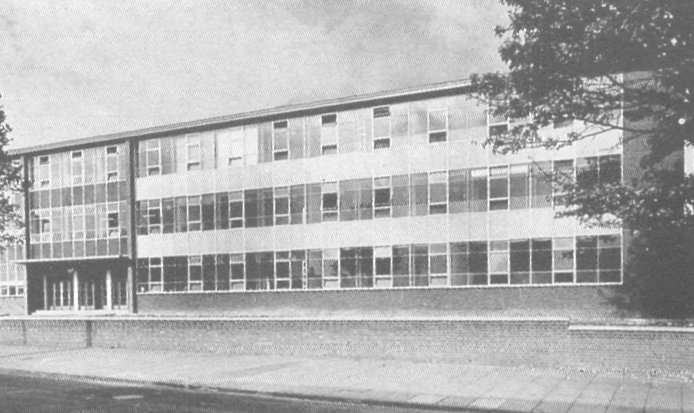
Staffordshire College of
Commerce. |
|
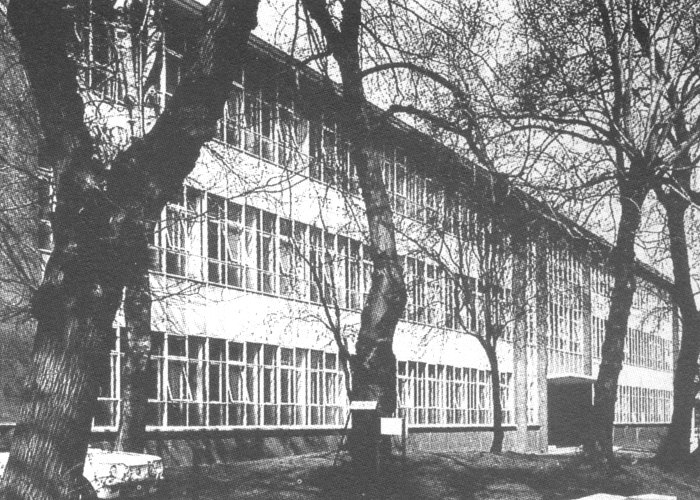
Staffordshire College of
Commerce after it had been extended in 1965. |
| The college continued to thrive, later
becoming part of the West Bromwich College of
Commerce and Technology. |
|
|
| Read about the Woden
Road South campus of the West Bromwich College of
Commerce and Technology |
 |
| |
|
|
Evening
Institutes
There were 2 evening institutes
which all became part of the technical and commercial
colleges:
Wednesbury
Evening Institute, Holyhead Road
Provided evening instruction in
technical, commercial and general subjects. The building
opened in 1896 and branch classes were held in Addison
Street Woodwork Centre and Lower High Street Primary
School. The technical and commercial classes prepared
young people for admission to the courses at the
technical and commercial colleges. There were
dressmaking, tailoring, homecraft, embroidery, woodwork,
elocution, and first-aid classes.
King's
Hill Evening Institute, King's Hill Secondary Modern
School, Old Park Road
Provided evening instruction in
dressmaking, woodwork, amateur radio and cookery.
|
 |
Return to
Education |
|